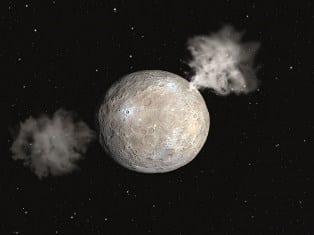Astronomers Locate “The Little Prince[‘s]” Home Planet*
As a child, UCF professor Humberto Campins, read “The Little Prince” by Antoine de Saint-Exupéry. The book was one of his earliest motivators in pursuing a career in astrophysics. Now, Campins is considered an international expert on asteroids. He is a member of NASA’s OSIRIS REx mission and the European Space Agency’s MarcoPolo-R mission, which both are being designed to travel to and retrieve samples from nearby asteroids. Campins also was on the first team to find evidence of water ice on an asteroid in 2010.
The journal, Nature, recently posted an article by Küppers et al online about Ceres, our solar system’s largest asteroid. Küppers et al documented the first direct observations of water vapor escaping from and surrounding the asteroid last year. They suggest this phenomenon is the result of volcanoes on Ceres. “Looks like ‘The Little Prince’ had it right all this time,” said Campins. “All kidding aside, the team’s research is significant because it gives us more clues as to how our solar system and Earth may have formed.”
Nature invited Campins to write an accompanying article in the journal to explain the potential significance of the European team’s work.
Scientists have long theorized Ceres has a lot of water. However, Küppers and his colleagues are the first to provide direct evidence of water molecules around Ceres through their work with the European Space Angency’s Herschel Space Observatory. Their results support previous indirect observational evidence of water on Ceres. This discovery couldn’t have come at a better time as NASA’s Dawn spacecraft will visit Ceres soon. This trip for the Dawn comes right after another successful mission to the asteroid Vesta.
In exploring Ceres and using the information already collected from Vesta, astronomers will gain a better understanding of why the two asteroids are so close, but so different. Campins and his co-author Comfort, a recent UCF graduate, have suggested an answer in their article.
“Most likely Ceres formed in a colder, outer region of the nascent solar system than Vesta did, beyond the snow line — the distance from the young sun at which temperatures were low enough for water to condense into ice. But this hypothesis raises the question of why Ceres and Vesta are so close to each other at present. It has been suggested that soon after the formation of the asteroids and the planets there was mixing of material from the inner and outer regions of our solar system. This mixing was caused by the orbital migration of Jupiter and the other giant planets from their initial positions to where we see them today. This migration and mixing could have moved Ceres and Vesta from very distant original formation sites to their current locations. ”
This is the same theory that suggests that asteroids rich in water and organic material may have brought Earth its first building blocks for life.
“We’re not done with the puzzle yet,” Campins said. “We are learning a lot and more is likely to be discovered through further studies of the miniature worlds we call asteroids.”
For more information on Ceres and to read the original article in UCFToday, click here.

